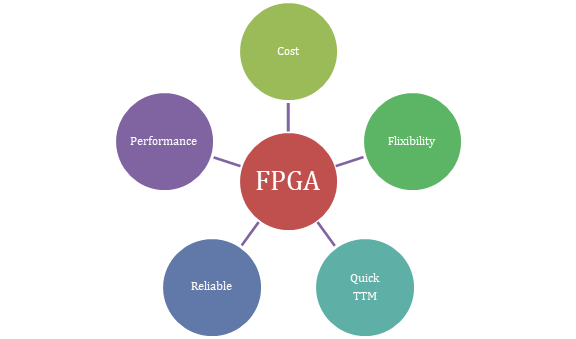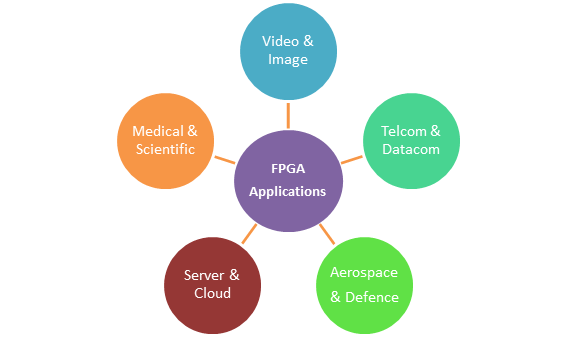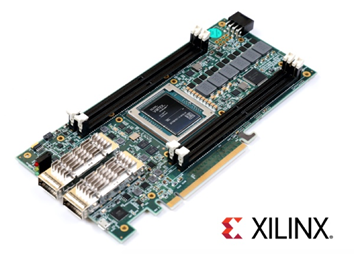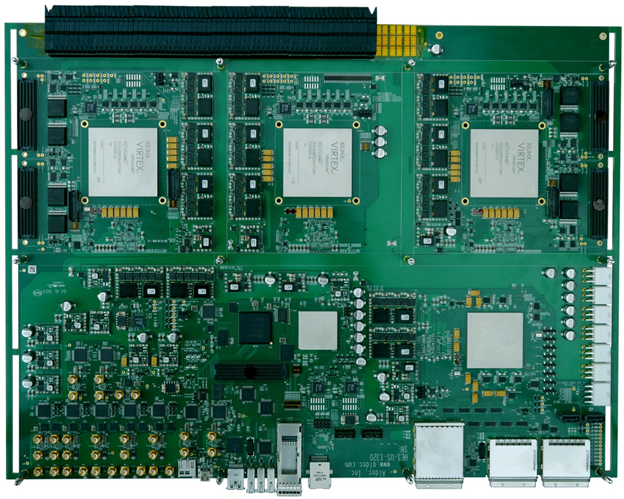This website uses cookies so that we can provide you with the best user experience possible. Cookie information is stored in your browser and performs functions such as recognising you when you return to our website and helping our team to understand which sections of the website you find most interesting and useful.
FPGA Advantages and Most Common Applications
23/12/2018, hardwarebee
FPGA stands for Field Programmable Gate Array. It is a digital programable chip that is used in electronic products and offers re-programmability capability. This semiconductor chip is based on programmable interconnection circuits and programmable logic blocks which can be modified to suit the needs of the user. With thousands of logic blocks placed on a single chip and each capable of executing logic functions, FPGAs are able to complete implementations at high speeds and with incredible efficiency. Compared to ASICs, or Application Specific Integrated Circuits, FPGAs are quickly manufactured, are relatively cheaper, and are much more flexible.
The following article will describe FPGA advantages and the most common applications that are utilizing FPGAs.
FPGA Advantages
Improved performance
One advantage is the parallel nature of the FPGAs that allows them to offer higher processing power and speeds and this they give better response times and an overall improved performance as compared to other modern microprocessors. FPGA’s hardware is design to perform a specific task, e.g. all the chip hardware is configured according the user code, whereas a microprocessor is running software on a general-purpose hardware. The dataflow and processing speed are also rather limited in microprocessors, a factor which is much better and improved in FPGAs.
Reduced costs
The second advantage is cost. Compared to the costs of ASIC manufacturing, FPGAs are very cost effective and relatively cheap. This makes them the perfect for low volume and mid-volume size production runs. ASIC, requires longer design cycle and higher NRE (maskset, IPs) and production tooling that can cost more than $1M. A small design mistake in an ASIC will require a new re-spin to produce a new chip, whereas an FPGA can just have a new program to upload.

Quicker time to market
The re-programmability of FPGAs is a big advantage, so that it can be used for prototyping purposes and and designs can be tested out or verified through these FPGAs before they are fabricated in the form of ASICs, for example. To add to that the fact that multiple steps of the development can be performed simultaneously owing to its parallelization as well as the fact that it can be updated and upgraded at any stage of the way even at customer’s site (post-sell).
More flexible and reliable
The flexibility of FPGAs stems from the fact that these semiconductor chips are reprogrammable and reusable, which means that even if you were to make a mistake in the programming, you can modify it or you can use these steps to create prototypes which can then be converted into permanent ASICs. Microcontrollers hardware are fixed and permanent, meaning in order to modify them, we need to make changes in the hardware. With FPGAs on the other hand, these changes can be made simply by reprogramming the chip to reconfigure the logic cells in FPGAs and their interconnections The parallel execution of FPGAs also adds a layer of trusted reliability to the system.
Low maintenance
Unlike ASICs, FPGAs do not need to be upgraded or maintained in the same way as they are reprogrammable and can be upgraded or enhanced without a great deal of time and resource investment that would be required to reconfigure permanent circuit boards and hardware.
Common Applications of FPGAs
Since FPGAs work in a parallel fashion, they boast much higher speeds and thus can be used to solve complex computable problems, together with the re-programmability ability — this makes FPGAs both powerful and flexible machines. Some of the most common uses and applications for FPGAs today are:

- FPGA is being used frequently and extensively in communication systems to improve network capacity, coverage, as well quality of service while simultaneously reducing latency and delays, especially when it comes to the data manipulation. For example, in Server or cloud applications, companies are using FPGA extensively. Read here an article by Forbes about the usage of FPGA in datacenters.

Xilinx FPGAs are being offered by Amazon Web Services to accelerate compute intensive applications.
- The use of FPGA in automotive and vehicles allows application such as ADAR, LiDAR and autonomous driving. for a reduction in energy consumption, and improvement in efficiency, an increase in the power and communications systems, strengthened security systems, as well as a reduced overall cost. A very nice article by ElectronicDesign.com offer more details on how to integrate FPGA into the future car.
- In the business industry, the FPGA chips are opening up new doors for automation and secure technology which can help business owners and factory runners counter security threats and risks and enable the growth of automation in the workplace. Similar to the industrial hemisphere, FPGAs are also being used in the defense department for increased security, cyber or otherwise, as well as increased automation in vehicles and weapons.
- FPGAs are being used extensively over a wide range of other fields such as in medical equipment, computer hardware, and radio devices. They are also being implemented in the likes of bioinformatics, voice recognition technology, security and communications systems- wired or wireless, and in a number of scientific, medical, and consumer electronics.
- Since FPGAs have a large internal memory along with a great number of multipliers, they are being used as signal processing systems and digital signal processing applications. The logic blocks of FPGAs are being used for image and video processing.
- FPGAs are used for the purpose of hardware and algorithm acceleration as well as for accelerating artificial neural networks or machine learning applications as is being done Microsoft in their Project Catapult.
- These are ideal for use in low volume, vertical application productions as it may prove to be more affordable than an ASIC.
- The use of FPGAs is becoming increasingly more frequent as compared to microcontrollers for the Internet of Things as it allows fast processing of multiple aspects in a parallel and simultaneous fashion.
- They are ideal for use for high end control applications where an advanced degree of control is needed.
- ASIC emulation and verification can be done using FPGA (or several FPGAs connected on a single board). The FPGAs together can simulate and ASIC and allow engineers to perform testing and verification before they take the ASIC to production. The following image is showing a typical emulation board by Aldec.

TYPES OF FPGAs
FPGAs can be divided or classified into three basic types based on their applications as described above:
Low End FPGAs
Low end FPGAs are ideal for systems that demand low power consumption, logic density, and complexity on the chip.
Mid Range FPGAs
Mid range FPGAs are a marriage between performance and price and are considered to be the ideal solution in most cases as it balances out the density, complexity, and consumption per chip with the cost without compromising too much on either of the factors.
High End FPGAs
While high end FPGAs may be expensive and comparatively consume more power, they also offer the best functionality with the highest logic density and complexity, and the best overall performance.
Conclusions
At the end of the day, FPGA offers customizable and powerful computing solutions at a relatively lower cost and leaving behind less of a carbon footprint as compared to some of the other technology in its bracket that is no longer able to provide optimum solutions to modern computing problems.










